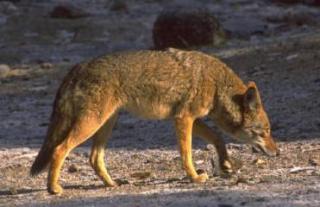Coyotes

The coyote resembles a medium-sized dog in body size and shape, but has a more narrower head & pointed snout.
Coloration varies considerably ranging from blond, light tan, or silver to dark blotchy brown and black.Other identifying characteristics include its erect, pointed ears and long black-tipped bushy tail. Coyotes are opportunistic predators. Their preferred foods include rodents, rabbits, deer, fruits & berries and occasionally birds, reptiles & insects. They can also prey on unprotected pets, especially house cats and occasionally dogs.
Breeding occurs in February or March and up to 4 - 8 pups are born in April or May. The family usually stays together until fall, then separates.
There are no effective nor registered repellents currently available for use on coyotes in New England. Auditory and visual scare devices may provide temporary protection during critical exposure periods, however, coyotes become accustomed to and quickly ignore stationary devices that are not periodically moved to new locations.
To help avoid problems with coyotes here are some basic steps to follow:
- Do not feed. Feeding will alter the animals behavior, they will become dependent upon and less wary of humans.
- Do not approach or try to pet. Although coyotes do not pose an imminent threat to humans, do not provoke by coming too close.
- Don't let coyotes intimidate you. Don't hesitate to scare or threaten coyotes with loud noises, bright light or water.
- Do not leave pet food outdoors. If you must feed pets outside the house provide only the amount your pet will finish in one feeding. Coyotes will not hesitate to eat foods placed outdoors.
- Secure your garbage. Coyotes, like dogs & raccoons will knock over trash cans or tear open trash bags left in the open.
- Do not feed wild birds. Seed left on the ground can attract coyotes. Also bird feeders with standing water are targets for coyotes and other animals.
- Secure your pets. Coyotes and foxes view pets as potential food items. For the safety of your animals, pets should not be left outdoors unattended.
- Close off craw spaces under porches and sheds. Coyotes use such areas for resting and raising young.
- Cut back brushy edges in your yard. These areas provide cover for coyotes and their prey
- Educate your neighbors. Pass this info

